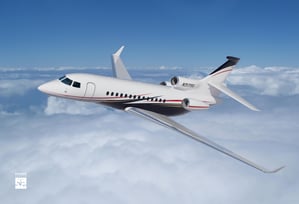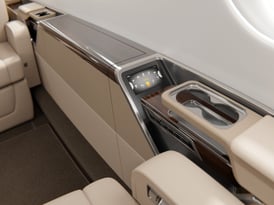We recently expanded our 3D design capabilities by adding Dan Ryba, a multimedia artist specializing in 3D illustrations, to our in-house aircraft interior and paint design team. Ryba joins Ken Reita and the design team, who have been creating innovative designs for clients on all makes of aircraft.
Both Reita and Ryba are focused on creating 3D conceptual illustrations for clients who are looking to make interior and exterior modifications to their aircraft.
2.jpg?width=603&height=122&name=Global%209085%20LH%20Elevation%2001.136%20(edits)2.jpg)
“These 3D renderings save a great deal of time and money, so they’re popular with all of our clients , internal sales and production people,” says Ken. “Unlike with 2D drawings, we can draw from our extensive engineering database and generate accurate 3D models of the entire interior that are specific to the actual measurements of an aircraft. You can see immediately what works and what doesn’t.”
There have been times when a client is torn between two materials. One may be darker than the other, and explaining that the darker material will give the space a dark, closed-in feel isn’t nearly as effective as a 3D image that shows exactly how the space will be perceived.
3.jpg?width=206&name=FWD%20To%20AFT%20Cabin%20View%2001(Drinkrail%20Switches)3.jpg) “When clients look at the illustration, they might say, ‘Whoa! The darker material is too heavy for that space. Let’s go with the lighter color.’ Or, if they really want that dark color, we can suggest other options, such as going with a lighter color on the leather seats or carpet to provide more of a contrast and get the ratio of light to dark correct,” says Dan. “It’s far better to find out on the front end before any work has been done on a project. Our clients especially appreciate being able to see exactly what they’re getting.”
“When clients look at the illustration, they might say, ‘Whoa! The darker material is too heavy for that space. Let’s go with the lighter color.’ Or, if they really want that dark color, we can suggest other options, such as going with a lighter color on the leather seats or carpet to provide more of a contrast and get the ratio of light to dark correct,” says Dan. “It’s far better to find out on the front end before any work has been done on a project. Our clients especially appreciate being able to see exactly what they’re getting.”
The 3D models are beneficial to our production teams, too. Seeing the model helps everyone with project planning, long before any work begins.
3D Graphics In Work
“Recently, a client, interior team lead, engineer, salesperson, and I were sitting at a conference table with a 3D preliminary concept of a credenza,” says Ken. “Using the 3D model as a focal point for our discussion, we went through each modification. For the cabinet, the client wanted to see where the electronics would plug in and how they’d look sitting on the shelves. The engineer looked over the model to see how to mitigate heat build-up and where to put the ventilation and wiring. The team leader wanted to make sure the Cabinet shop could build the shelves and install pocket doors with the rounded edges and corners in the design. I was concerned about retaining the beauty and balance of the design. With all of our input, we figured it out pretty quickly, before any production was started.”


There are other times when it’s not convenient for the client to meet face-to-face, so the Duncan Aviation sales team can request a 3D image of the design for the client and include it in the sales package, saving everyone involved time and money.
Seeing is believing, so giving clients and production teams a visual representation of the finished aircraft, inside and out, helps prevent surprises along the way.
For more information about Duncan Aviation’s modifications services, visit Duncan Aviation at booth #C9125 during this year’s NBAA convention from October 10-12, in Las Vegas, Nevada, or watch for announcements at www.DuncanAviation.aero/nbaa.


